Final report for FW14-019
Project Information
The main objectives of this multi-year project were to: 1) Evaluate how planting times, seeding rates, and seeding equipment affected multi-species cover crop establishment. 2) Investigate three different cover crop multi species mixes and five single species mixes on the following parameters: soil compaction, tree nutrient uptake, fruit size and firmness, and fruit yield. 3) Quantify economics of cover crops, including cost of seed, cost of establishment, nutrient contributions, pest and disease influence, management costs, tree growth and fruit quality and yield. 4) Encourage the adoption of multi-species cover crop mixes amongst commercial orchardists in the region and beyond.
Currently, conventional management of the orchard floor in Pacific Northwest orchards involves using herbicides to keep a bare strip of soil directly under the tree rows and maintaining a perennial grass sod alleyway between the tree rows. The grass sod, predominantly creeping red fescue and perennial rye, does a good job of preventing soil erosion but provides few of the other benefits cover crops offer. The sod root systems are relatively shallow, don’t scavenge effectively for nutrients, don’t increase the soil microbial life beneficial to tree health, nor do they provide nectar or pollen to beneficial insects. Planting cover crops in the alleyways could increase the sustainability of tree fruit orchards but this practice is not utilized at all in the Mid-Columbia region, according to our local Oregon State University Extension office.
Multi-species cover crop “cocktails” have been utilized more extensively in annual cropping systems and have been shown to improve soils and crop yields in ways that researchers still don’t fully understand. Although it was not within the scope of this small project to understand all the mechanisms at play with respect to cover cropping benefits, we tried to identify the best cover crop mixes for our region and understand how they impact fruit quality and economic return to the grower. It was important to find out what works best in an orchard system, our local microclimate, soils, set of equipment, and other factors. This way we can inform other growers about how to be successful with cover crops on their operation. We understood if the cover cropping results were positive, it should lead to increased adoption of the practice by orchardists in the region and increased sustainability of the orchard cropping systems.
The project was conducted in a mature cherry block (Chelan variety) at Omeg Family Orchards in The Dalles, Oregon. Single row alleyway treatments will be planted to cover crop mixes with multiple data points collected throughout their growing cycle.
The results of our study are contained herein. Highlights include:
- An ATV with seeder mounted works well for sowing cover crops but requires more seed per acre. It is also the cheapest equipment to purchase.
- A no-till drill is effective but is the highest costs per acre to operate and the most expensive machine to purchase. Tillage is still required before planting to get the best stands.
- A power harrow with integrated pneumatic seeder does an excellent job establishing a cover crop in a single pass. The harrow has the lowest machinery and labor costs and a moderate price tag to purchase the machine.
- Fall is the most desirable time to plant. Spring and summer plantings suffer from equipment driving over the growing crop and shade from the canopy stunts the growing plants.
- A mix of ‘Bounty’ annual ryegrass, ‘Enricher’ radish, Phacelia, ‘Bayou’ kale and ‘Shield’ mustard performed the best for us. ‘Bounty’ annual ryegrass and ‘Enricher’ radish also did well planted as a single species.
- Soil nutrient levels were not different between treatments or the control.
- Soil quality in the alleyway improved with cover crops. Reductions were observed in compaction and infiltration rate was increased.
- There was no difference in tree leaf nutrient levels, shoot growth/caliper or fruit/size or quality from any of the cover crops.
- “Mow and blow” may be a way to make alleyway cover crops contribute to the tree crop. A follow-up project was funded and has been started investigating the benefits of mulching cover crops via mow and blow in orchard systems.
1. To research how planting times, seeding rates, and seeding equipment affects multi-species cover crop establishment.
2. To research three different cover crop multi species mixes and five single species mixes on the following parameters: soil compaction, tree nutrient uptake, fruit size and firmness, and fruit yield.
3. To quantify economics of cover crops, including the following parameters: cost of seed, cost of establishment, nutrient contributions, pest and disease hotspots, management costs, fruit yield and quality.
4. To encourage the adoption of multi-species cover crop mixes amongst commercial orchardists in the region and beyond.
Cooperators
Research
Location
A ‘Chelan’ orchard on Mazzard rootstock was selected for the trial. Located just outside The Dalles, Oregon, the orchard is 10 years old and planted on soil of classification 13B-Chenoweth loam. The soil is considered very good for cherry orchards by local growers. The orchard is irrigated with Netafim Supernet sprinklers which are able cover the entire alleyway using long throw spinners. About 2 acre feet of irrigation is applied annually. Single row treatments were planted to various cover crop species.
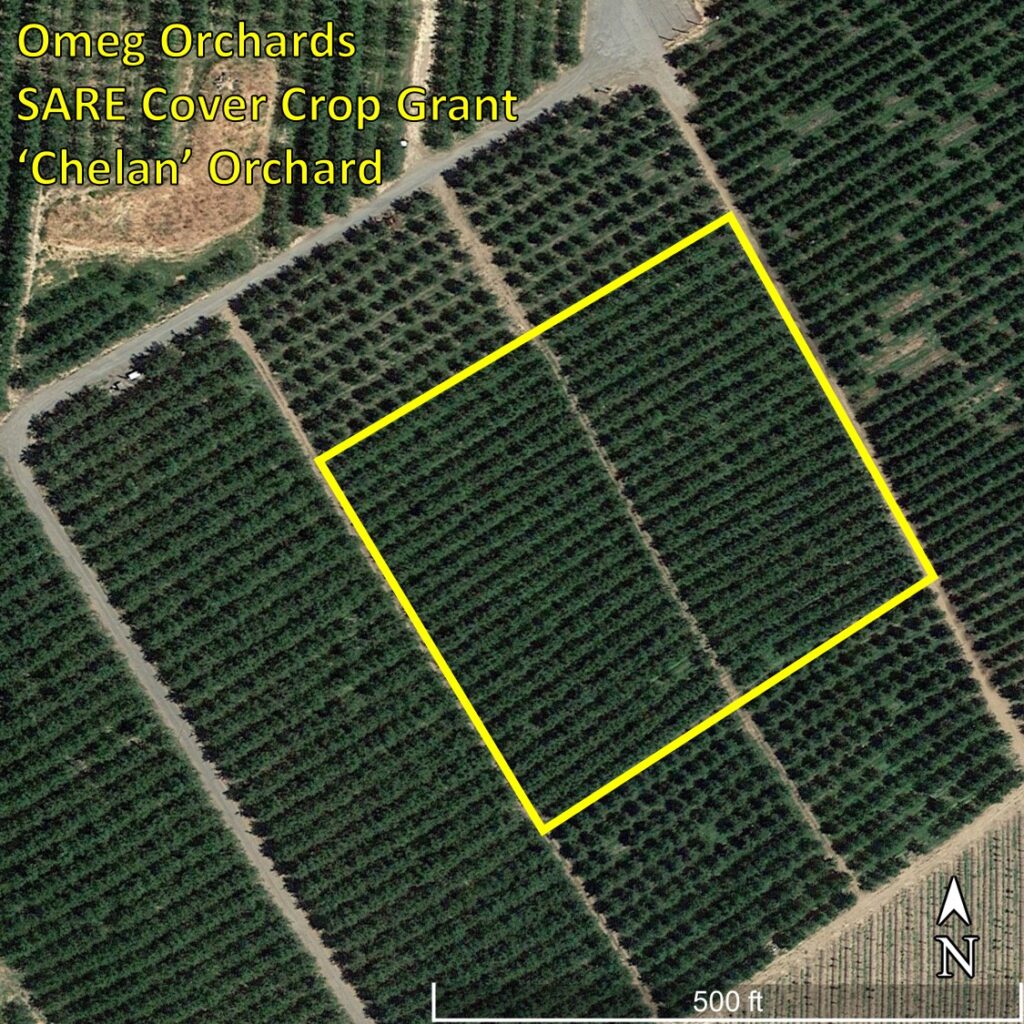
Plot Map: The experiment was conducted at this orchard because a historic freeze in fall of 2014 killed many trees in the proposed orchard site.
Equipment
Three pieces of equipment for planting the cover crop seeds were evaluated:
- ATV-mounted broadcast seeder. We used a Honda Recon 250 ATV with a Cabela's ATV Spreader and Feeder. This set-up was evaluated because the equipment is commonly used in orchards and of relatively low cost.
- No-till drill. A Land Pride 606NT No-Till Compact Drill with native seed box option was mounted to one of our orchard tractors. We wanted to be able to plant seed into existing alleyway sod without tillage. Our goal was to minimize tillage and the negative soil quality impacts associated with it.
- Power harrow with air seeder. A Moreni VITIS K power harrow with STONE-SYSTEM, Model 1500, Packer Roller with integrated APV PS 120 air seeder with MX-35 speed sensor was mounted to one of our orchard tractors. A neighbor has been using a power harrow to level his alleyways for many years and we saw that we could do light tillage with such a unit to minimize soil disturbance.
For each piece of equipment we noted our experiences with:
- Calibration: It is important to ensure that a proper amount of seed is applied.
Calibrating the seeder ensures that dollars are not wasted over or under seeding since some cover crop seed mixes can be expensive per acre.
- Operation: We wanted to find equipment that was easy to operate, durable and reliable.
- Cost of Operation: How much it cost the business to run the planting equipment was recorded. We wanted to use equipment that was cost effective to operate.
- Consistency of stand: The goal was to have a nice stand of cover crop grow after planting. How well the stands established and grew with each set-up was evaluated.
Planting Date
Several planting dates were evaluated: spring (mid-March), summer (early August) and fall (Early October) planting. Our goal was to determine the optimal date of planting which would generate the greatest impact upon the soil quality, tree nutrient uptake and fruit size, firmness and yield.
Seed Mix
Three multi-species seed mixes and five single species were evaluated, including planting time and seeding rate for each. After referencing the available literature, especially Cover Cropping in Vineyards: An introduction to vineyard cover crop management from University of California Extension, and consulting with the experts from our cover crop seed company at Saddle Butte Ag we choose to plant the following:
|
SEED MIX 1 |
SEED MIX 2 |
SEED MIX 3 |
|||
|
‘Bounty’ Annual Ryegrass |
54% |
Spring Oats
|
86% |
‘Bounty’ Annual Ryegrass |
71% |
|
‘Enricher’ Radish |
10% |
Naomi Vetch
|
14% |
‘Enricher’ Radish |
11% |
|
‘Bayou’ Forage Kale |
7% |
|
|
Phacelia tanacetifolia |
7% |
|
Phacelia tanacetifolia |
7% |
|
|
‘Bayou’ Forage Kale |
7% |
|
Subclover |
7% |
|
|
‘Shield’ Mustard |
4% |
|
Ethiopian Cabbage |
10% |
|
|
|
|
|
‘Shield’ Mustard |
5% |
|
|
|
|
Single Species 1: Sorghum-sudangrass hybrid
Single Species 2: ‘Enricher’ Radish
Single Species 3: ‘Bounty’ Ryegrass
Single Species 4: Buckwheat
Single Species 5: Triticale
“Control” species: an alleyway with a typical of Northwest orchards- a permanent sod of perennial rye (of unknown cultivar) and “weeds” (mostly dandelion and broadleaf plantain).
We should note that we avoided legumes, except vetch, because gophers and voles are a real problem for our growing area and are encouraged by legumes, especially clovers. A paper, Cover Crops Influence Meadow Vole Presence in Organic Orchards, by Dr. Granatstein, outlines the challenge of legume cover crops and voles in orchard systems.
Tree Sampling
Healthy trees have good nutrient balance and growth. To evaluate nutrient uptake and growth we conducted the following sampling:
- Leaf samples were submitted to determine tree nutrient uptake.
- Shoot extension and caliper was observed and noted each fall. 10 shoots from 10 healthy trees were selected in each block. The shoot length and the caliper at 2 inches from base was recorded. Pest and/or disease presence was noted. The data were analyzed using an independent t-test in Microsoft Excel.
Fruit Sampling
The amount paid to the grower per pound is determined by fruit size and firmness. The larger and firmer the fruit the more gross return per pound to the grower so evaluating these qualities is critical. 200 cherries were samples at harvest and fruit size and firmness was evaluated using a BioWorks FirmTec 2, the cherry industry standard method. The data were analyzed using an independent t-test in Microsoft Excel.
Soil Sampling
Improving soil quality is an important means by which cover cropping will benefit the orchard. We conducted the following to determine the impacts of the cover crops on the soil:
- Soil Samples: Standard soil samples were collected using Logan Labs’ standard soil sampling method and submitted for analysis. These data indicated the nutrient contribution of the cover crops to the soil.
- Penetrometer: Periodic penetrometer readings were taken as a measurement of soil compaction using a Pike Agri-Lab Supplies HyPen1. 100 readings were taken in each treatment. In other cropping systems soil compaction has been alleviated using cover crops, thereby increasing soil quality. We wanted to determine if the cover crops did the same for our orchard.
- Soil infiltration: Soil infiltration was measured in the last year of the study under the mulch in “mow and blow” mulch treatments. We followed a simple method using PVC pipe described on Youtube “Soil Test 3 - How to measure infiltration”. We put 8oz of water into a 6 inch PVC ring. This method was fast and simple. Twenty points in each treatment were taken and the data later compared.
Economic Impacts
Ultimately growers are not likely to adopt management practices if there is not a net economic benefit to their business. To determine the economic impacts of the cover crop treatments we looked at the expenses and income listed below.
Expenses:
- Cost of establishment
- We used the cost to purchase the seed calculated on a per acre of cover crop. Given the different tree row spacings and alleyway widths we are not able to calculate the expense on a per acre of orchard basis.
- To determine our machinery operation we used the Enterprise Budget AEB 0032 from Oregon State University “Orchard Economics: The Costs and Returns of Establishing and Producing High-Density Sweet Cherries In Wasco County”. We did not figure the cost of purchasing or renting the equipment into our study as the per acre costs would depend upon the number of acres treated.
- Labor to prep and plant was recorded.
- Additional Labor and management. Any additional labor or management for the cover crops was also recorded.
- Weed control. Any weed control costs or savings was recorded.
Income:
Any loss or increase in income was calculated using the price per pound received by the grower (Omeg Family Orchards) for each row size of fruit multiplied by the size distribution of a 200 fruit sample collected from each treatment. Culls and brine fruit were not calculated as their return does not have a significant impact on grower income.
Mow and Blow
After collecting data from and observing this trial we quickly learned that “mow and blow” made the cover crops much more effective than simply leaving the cover crops in the alleyway. We used a Nobili SDS 210 flail mower with the independent hydraulic system drive and a single-side auger discharge to mow and blow our cover crops.
Planting Equipment
- ATV-mounted broadcast seeder. We quickly abandoned the use of the ATV in favor of the other two pieces of equipment. The Cabela's ATV Spreader and Feeder was difficult to calibrate and did not distribute the seed evenly, leading to inconsistent stands. Maintaining a constant speed in the orchard was a challenge that we never fully overcame. A smart phone with a GPS speed app worked great, as our ATV does not have a speedometer, but the uneven terrain and need to avoid obstacles, such as hanging branches, made it difficult for the operator to maintain a constant speed. This method also required that the ground be tilled before application, which meant a tractor and tiller quickly ate up much of the equipment operation and labor savings from using the ATV and seeder. We tried seeding over newly mowed sod but the cover crop did not establish so we shallow tilled the alleyways first. However, simply seeding over the tilled ground did not do well for us. To get the best stands with the ATV required a second pass over the seeded ground with the ATV towing our Rankin drag mat we use behind our arena harrow. Overall the only savings the ATV method offered was not having to purchase an expensive seeder or drill. However, the cost of planting was higher than we expected as the ATV method required the most equipment passes and labor. In addition the cost of seed was higher with the ATV because we had to increase our seed/acre to get full stands. Generally the other equipment achieved the same stands with 30% less seed/acre. If a grower does not have a drill but does have a tractor, tiller and ATV and is willing to purchase an ATV seeder then this method would work to establish cover crops in the orchard without having to purchase expensive equipment.
- No-till drill. The Land Pride 606NT No-Till Compact Drill worked well for us. It did allow us to plant into the alleyway without tilling the soil. The unit was simple to calibrate and the seed was applied and emerged evenly. However, the sod proved to be real competition for the cover crop. We did not have any luck establishing a good stand of cover crop unless we killed the sod first. We tried flail mowing the sod to the ground and planting immediately afterwards. We also planted into the sod and then flailed. However, neither method let the cover crop establish well enough to compete with the sod. We tried two methods of “chemical mowing” the sod before planting: 1) apply a burndown herbicide and 2) apply glyphosate. Both methods allowed the cover crop to establish far better than mowing. However, the sod could sometimes outcompete the cover crop when a burndown was used. Glyphosate worked very well at virtually eliminating the sod competition and allowing the cover crop to establish. But applying these herbicides required another pass over the alleyway, a specialized boom setup (as orchards typically only spray the tree rows and do not have booms set for sod) and the cost of the herbicides. The drill did allow us to plant the cover crop without tillage but to get the stands we wanted we had to use more equipment, labor and herbicides. The drill was easy to operate and maintain. The sod cutting discs did not need replacing even after 100 acres or so of seeding.
- Power harrow with air seeder. The Moreni VITIS K power harrow and seeder proved to be the best setup for seeding the cover crops into the alleyways. The APV PS 120 air seeder was very easy to calibrate. The digital controls were straightforward and allowed for precise application of the seed. We purchased a MX-35 add-on speed sensor after the 1st year and really liked the additional features it offered. The sensor allowed us to precisely apply the seed even when we had to vary the tractor speed due to terrain or obstacles (or operator error). Maintenance of the seeder was easy and changing out of the seeder heads to accommodate small or large seeds was simple. The power harrow unit did a great job of tilling even in dry and rocky soils. We were able to set the unit depth to a shallow or deep. We found that tilling to a depth of 3 inches knocked out the sod and provided a nice seed bed for the cover crop to establish. Some spotty sod regrowth occurred but rarely did the cover crop not outcompete the sod. When we compared the no-till drill with glyphosate sod kill and the power harrow we saw a much better stand of cover crop. The better cover crop establishment is likely because the alleyways in orchards are very compacted from the many equipment passes (>12 tractor passes alone) that occur when growing the orchard crop. The light tillage allows the growing cover crop to establish in an area that is not compacted. The power harrow and seeder were easy to operate and maintain. In our soils we found the blades needed replaced after about 50 acres of tillage. An additional benefit of using this machine was that it leveled out the alleyway, reducing roughness of the terrain and thereby reducing equipment maintenance costs from “bouncing and shaking” over uneven ground.
|
Equipment |
Pros |
Cons |
|
ATV with seeder |
|
|
|
No-Till Drill |
|
|
|
Power harrow w/seeder |
|
|
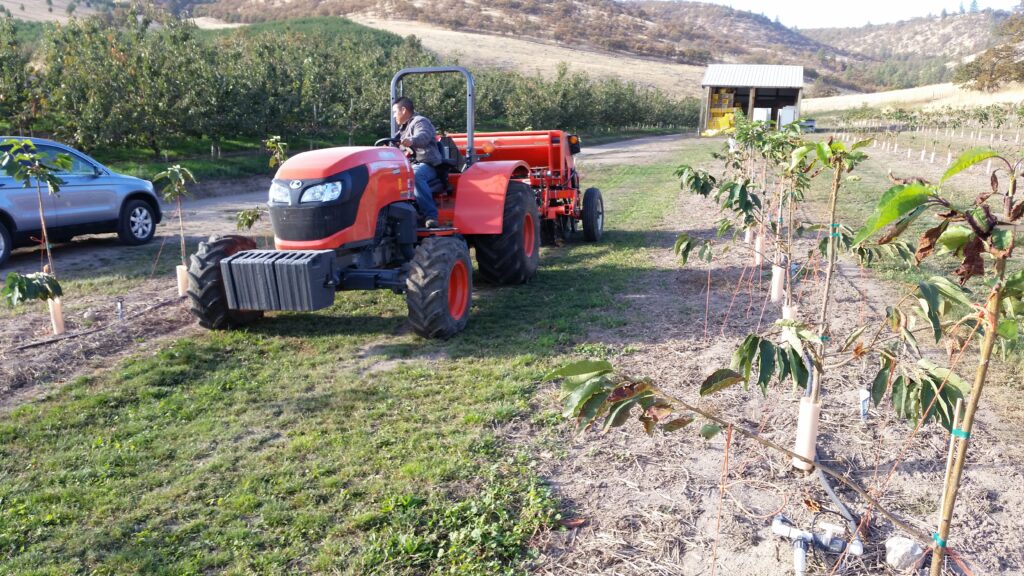
No-Till Drill: The Landpride 606NT No-Till Compact Drill was well sized for orchard systems. The machine was well built and easy to operate and maintain.
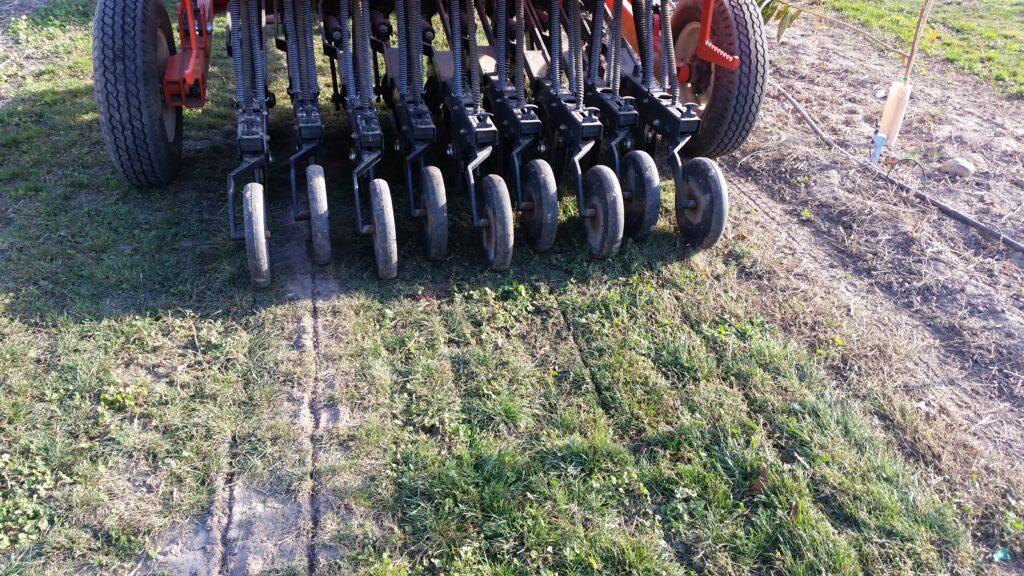
Drilling into sod: The drill easily planted the cover crops into existing sod. However, the stands established best when the alley was tilled before planting.
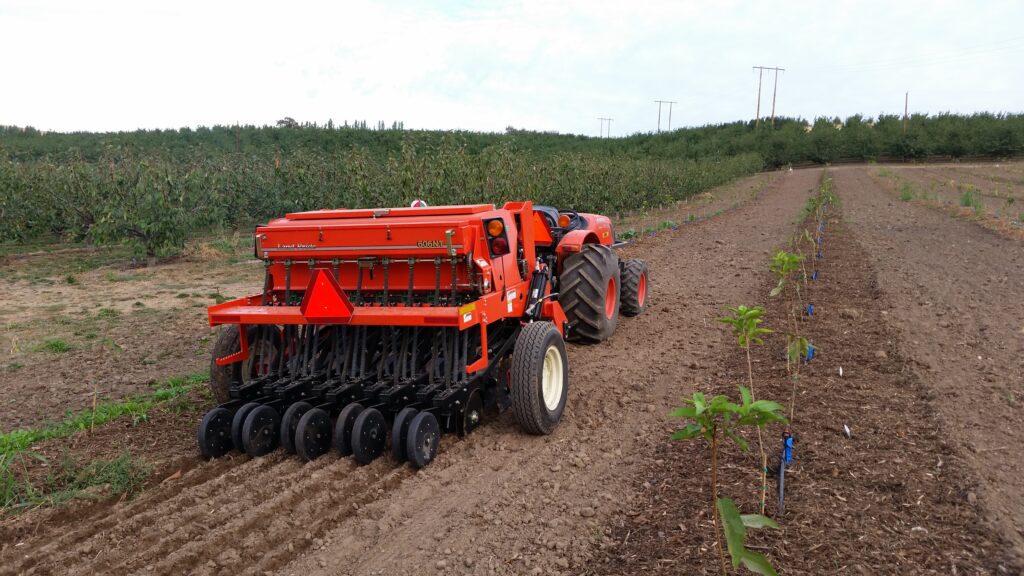
Drilling into a tilled alleyway: The drill worked well and the stands established best when the alley was tilled before planting.
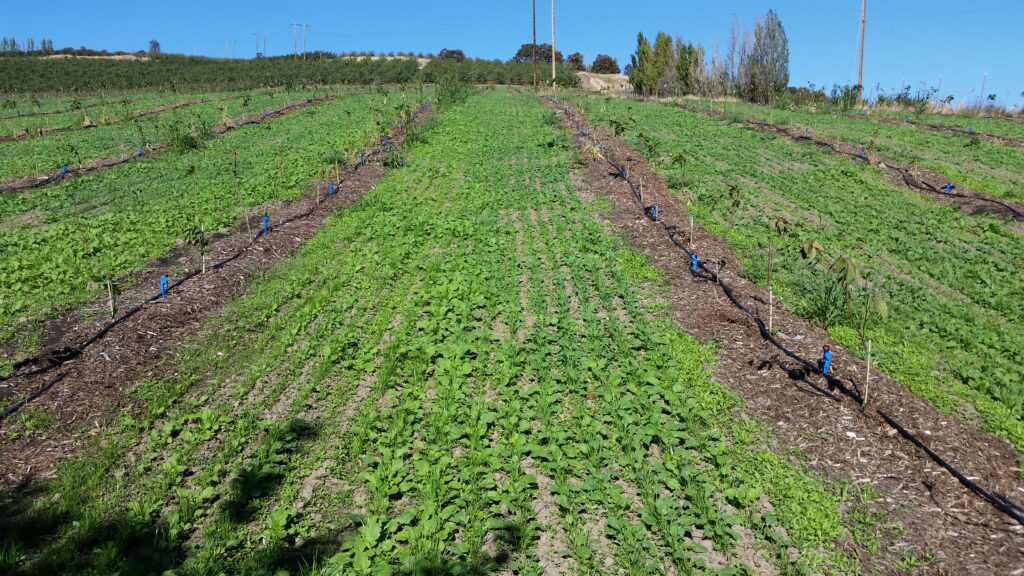
Drill planted stand: A stand of drill planted cover crop mix 1 sown in the fall timing, early October. The drill planted stands grew great but were the most expensive per acre for machinery and labor to plant.
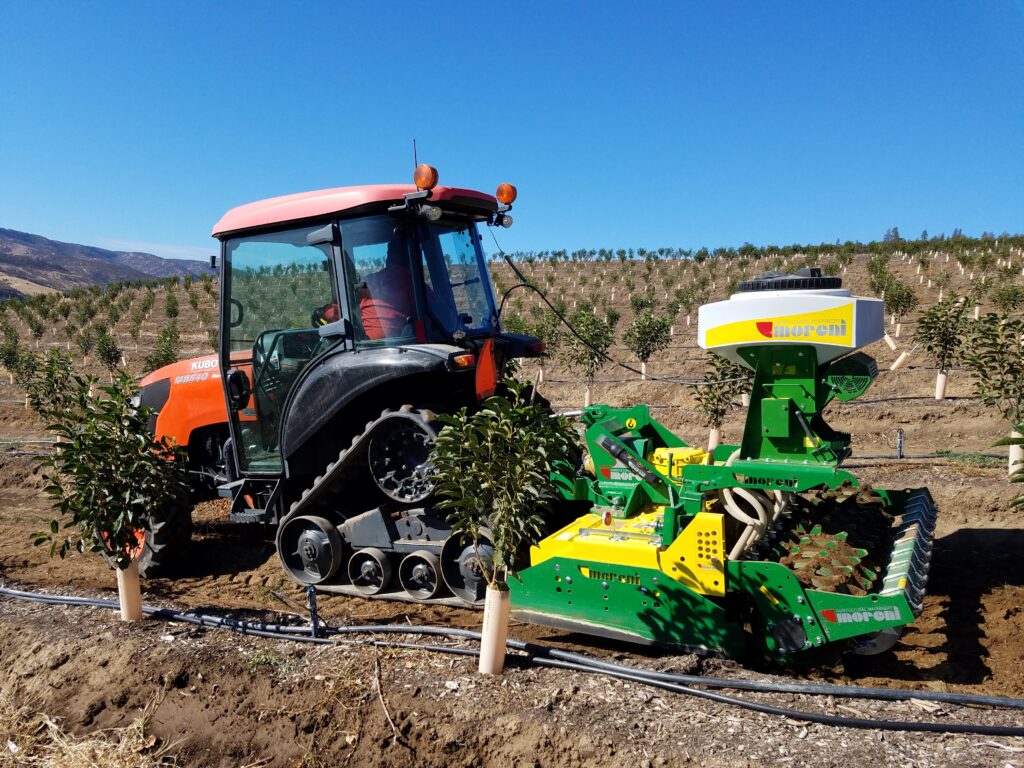
Power harrow seeding: The Moreni VITIS K power harrow and APV PS 120 air seeder proved to be the best setup for seeding the cover crops into the alleyways. It allowed planting the cover crop in a single pass.
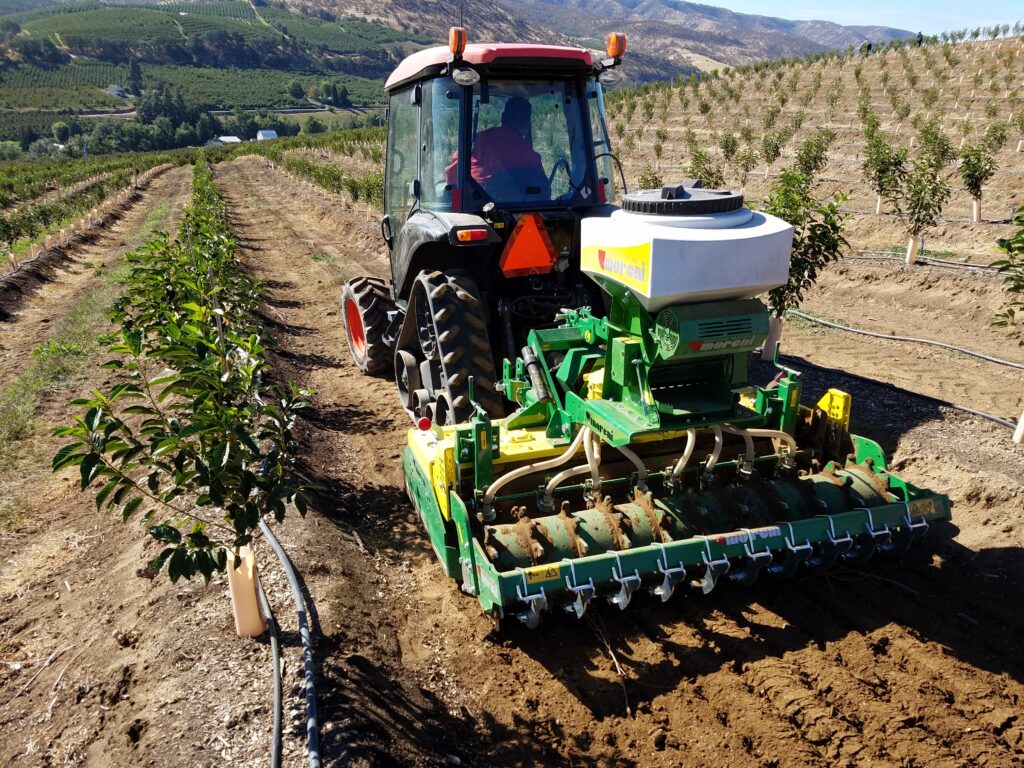
Power harrow seeding into young orchard: The power harrow did when seeding in freshly planted orchards or in rocky ground. It was easy to operate and established solid stands of cover crop.
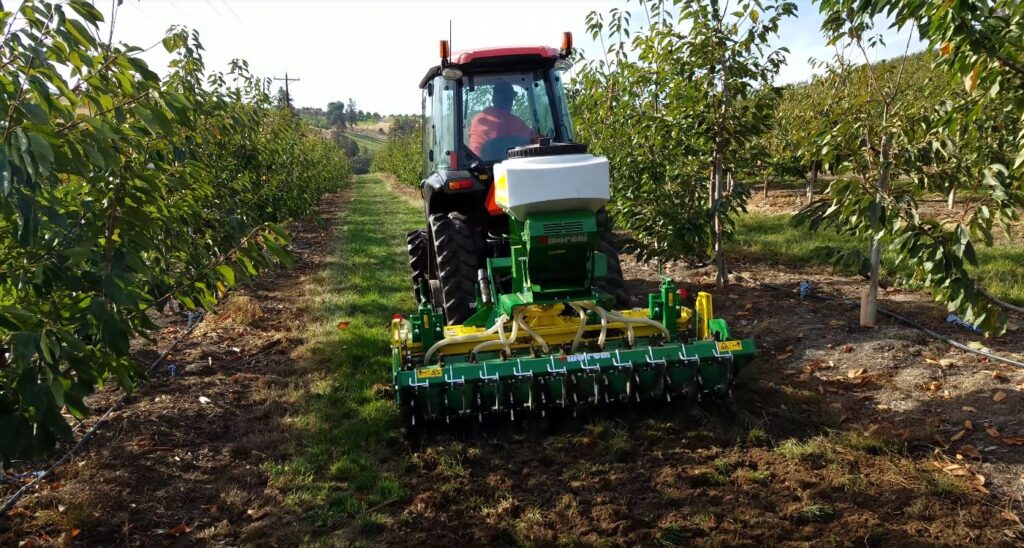
Power harrow seeding into sod: We set the harrow to till to a depth of 3 inches. This depth virtually eliminated sod regrowth and let the cover crop establish well while limiting soil disturbance.
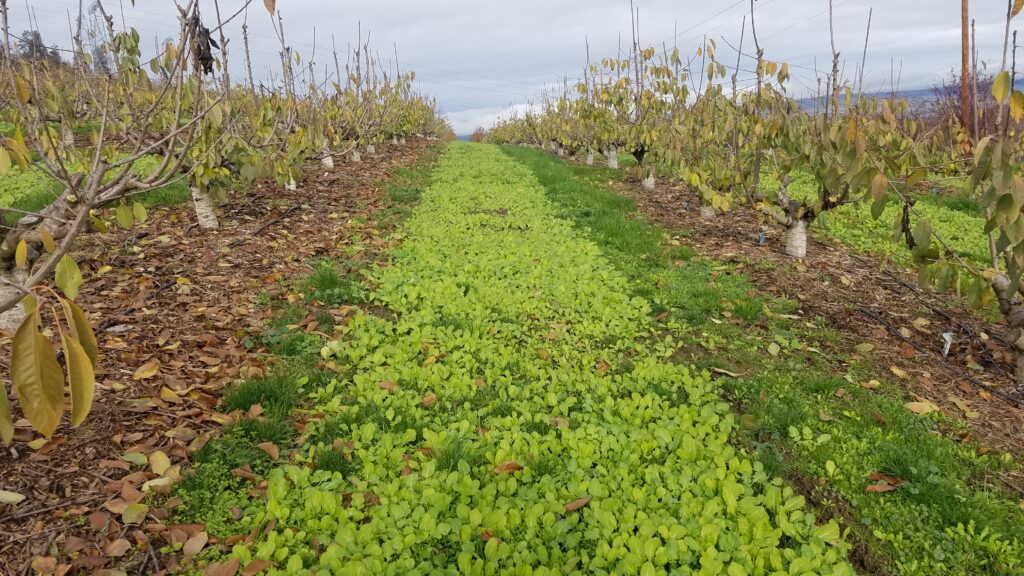
Fall sown tillage radish: The power harrow seeded this nice stand of fall sown tillage radish into sod. With narrow spacing such as this we generally only made one pass with our seeder, which is 6ft wide, in the 10ft wide alleyway.
Planting Date
We quickly learned a hard lesson about planting times: spring and summer plantings do not work in producing blocks. The multiple equipment passes over the alleyway from irrigation, pesticide applications, fertilizer applications, etc. knock down the cover crops, even low growing ones, to the point where the stand is very poor. In addition, it is difficult to let the stands grow tall and to their full potential because they interfere with application of foliar sprays to the orchard crop. There is also a safety issue with equipment driving over tall stands of cover crop on our steep terrain. The cover crop can become slick and the equipment slides off the alley. Even if the equipment passes over the cover crop are limited the shade from the tree canopy stunts the growth of the spring planted cover crop. We tried only driving equipment on every-other-row but the cover crops still did not thrive from the heavy shading created by the neighboring trees. The stands growing in shaded alleyways were had about 25% less biomass as stands in nearby non-bearing orchards where there was no shade. Non-bearing orchards can be planted in spring, summer or fall because the equipment operations taking place on non-bearing acres is far less than producing acres and there is no shading. The best time to plant in producing orchards is the fall, in our case early October. For the most part all orchard operations are wrapping-up at this time of year and little to no equipment is driving over the alleyway. Yet the weather is still warm enough for the cover crop to germinate and establish and irrigation water is available. We found in every instance that the fall planting established the best stands of cover crop. Even though orchards are pruned in the winter and the brush is shredded in the alleyway the cover crops seemed unaffected by this process. We did not see any negative impacts on the cover crops after shredding brush in the alleyways. We evaluated alleyways where brush was chopped and alleyways where no brush was chopped and found both cover crops always grew equally well when the spring temperatures warmed up.
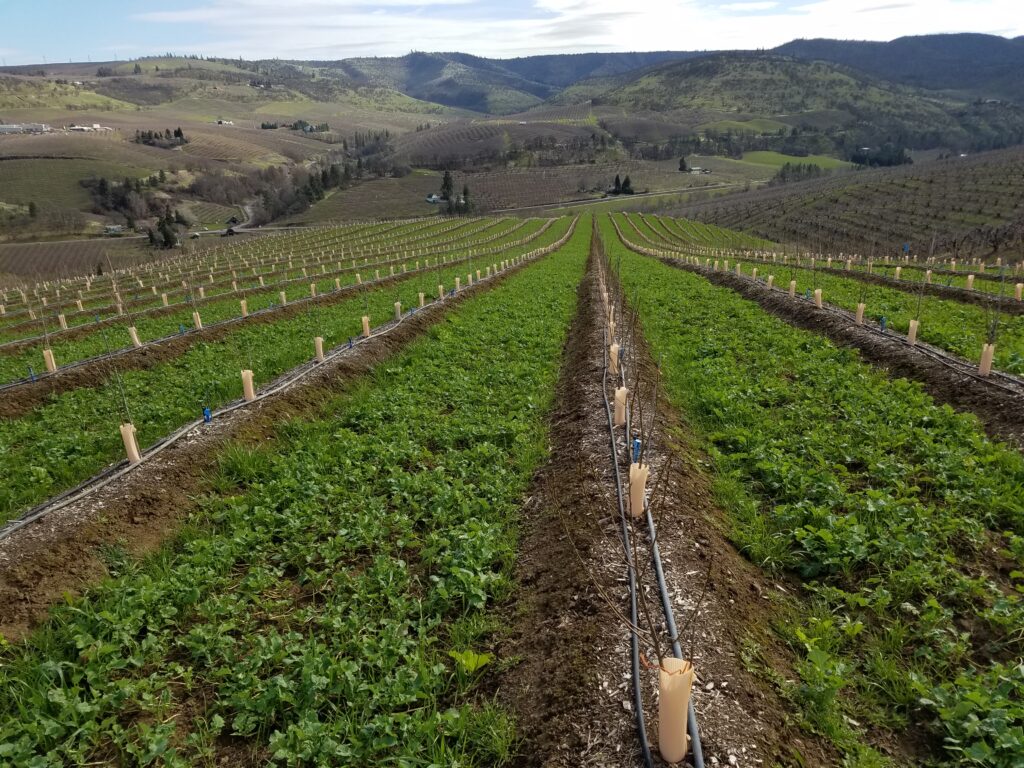
A fall sown stand shown in winter: This fall sown stand of Mix 3 had 45 days of snow on top of it a month before this photo was taken. Fall planting were always successful for us.
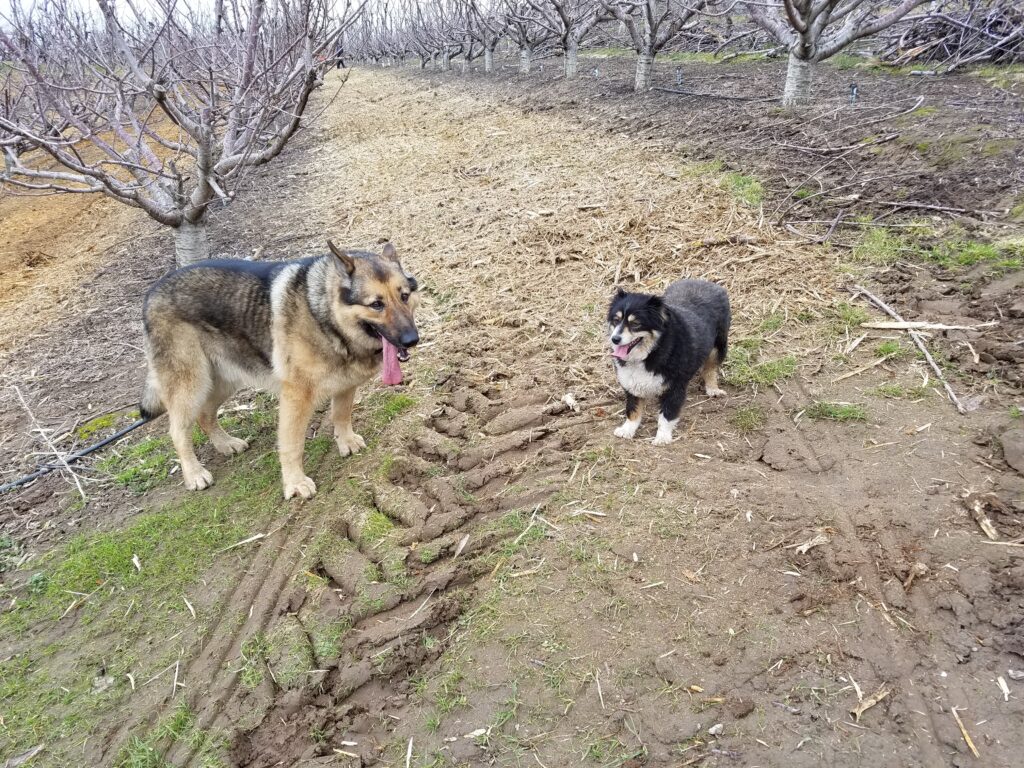
Brush shreddings on top of cover crop: The fall sown cover crops always regrew well after brush chopping of prunings. Here several inches of shredded branches sit above the cover crop. Yet the following spring the cover crop thrived in this alleyway. The stacks of unshredded brush awaiting the flail chopper can be seen in the upper right.
Seed Mix
We evaluated a number of species and found some worked better than others. Several did not work at all for us. The mixes worked great and we refined our species over time into “Mix 3”, the reasons for which are explained below. Seeding rates are listed under the “Expenses” section of these results.
|
Species |
Comments |
|
‘Bounty’ Ryegrass |
The annual ryegrass did well at any planting date. It grew well when planted as a single species or in mixes. The roots were extensive and, although no measurements were taken, our visual observation was that the ryegrass roots went deep (>24”) even in compacted alleyway soils. Ryegrass was the only species we tested that could compete with sod in the no-till drill plots if the sod mowed down first. The seed was low cost, widely available and had excellent germination. |
|
‘Enricher’ Radish |
The “tillage” radish was a winner for us whether planted on its own or in mixes. The radish seed was low cost, widely available and had excellent germination. The radish did well for us planted on the summer and fall planting dates. When planted at those times the radish roots would get very large, allowing for good root holes throughout the ground once the radish was winter killed. |
|
‘Bayou’ Forage Kale |
This kale/rape hybrid did great for us. It quickly established in the mixes and competed well with the other species. ‘Bayou’ regrew readily even after several mowings. The kale did not winter kill and many of the stems regrew the following year. It took equipment traffic well and would regrow even if the stem was bent down horizontally and laid on the ground. New shoots would sprout from each leaf joint and grow upward. This species did equally well planted spring, summer or fall but fall plantings were best. The seed was low cost, widely available and had excellent germination. Bees loved this plant when it bloomed. |
|
Phacelia tanacetifolia |
Established well in fall plantings. It grew quickly and had many fine roots. The very tiny seeds could be a challenge in some planters but did fine in our mixes. We occasionally had trouble sourcing seed at a reasonable cost. Bees absolutely loved this plant when it bloomed. |
|
Subclover |
We had little success with subclover in any of our treatments. Few if any established. |
|
Ethiopian Cabbage |
We had little success with this species in any of our treatments. We had no plants establish. |
|
‘Shield’ Mustard |
This species did very well for us. It established quickly and could easily shade out other plants in the mix if the proportion was too high. Although the foliage would winter kill the canopy quickly regrew from the crown in the spring. On one particularly cold winter most of the mustard plants were winterkilled and did not regrow. |
|
Spring Oats |
Spring oats did Ok. The plants grew quickly but the biomass produced was limited vs the other species evaluated and we preferred the annual rye over oats. However if a quick cover crop is needed oats would be a good choice. |
|
Naomi Vetch |
This vetch was nice as it grew a more compact plant that did not creep into the tree row as bad as some vetch species which grow locally and are the bane of micro sprinklers because of vetch vine entanglement. |
|
Sorghum-sudangrass |
We were expecting to have this species be a winner for us. However we quickly learned that the tree canopies shade out this plant and make it grow only a foot or two tall vs 6 ft tall in unshaded areas. In addition Sorghum-sudan does not take traffic well and dies out in the alleyway if equipment is passing through the orchard. Even in young blocks where shade is not an issue this species is not well suited because the few equipment passes that are made knock it back and it dies out. |
|
Buckwheat |
Buckwheat did not germinate well for us. Only a few plants grew and they did not do well under the shade of the canopy. |
|
Triticale |
Triticale did good for us, especially in fall plantings. However we liked annual rye better because Triticale did not recover as well after brush chopping activities in the winter. |
Although ‘Bounty’ Ryegrass and ‘Enricher’ Radish would establish solid stands for us when planted as a single species we preferred the mixes. When we planted Mix 1 we observed that the subclover and Ethiopian cabbage did poorly for us. So we eliminated them from the mix and created Mix 3. Mix 2 did well but produced far less biomass for us vs Mix 3. We found Mix 3 to be the best overall mix for us. It provided economical cost/ac for seed, established readily, especially at the fall planting time, which works best for producing orchards. The species in Mix 3 were able to handle occasional equipment traffic and all did fine even when brush chopping took place over them in the winter and very early spring.
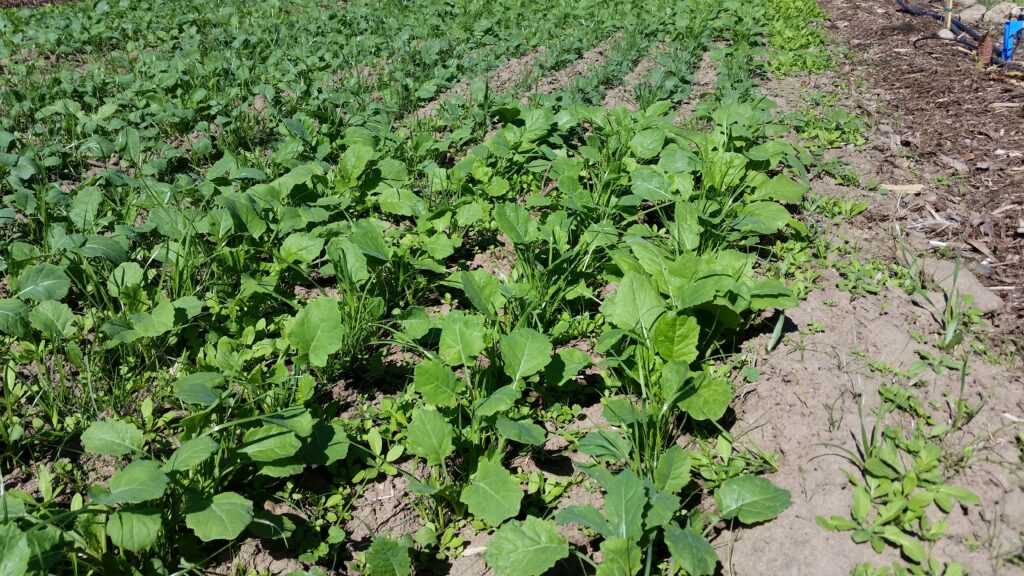
A young stand of Mix 3: We found that Mix 3 did best for us. The combination of species germinated well and was cost effective. It produced a considerable amount of root growth in both fine and giant (radish) size and an abundance of above ground biomass. In addition bees loved the flowers of the brassicas if they were allowed to bloom.
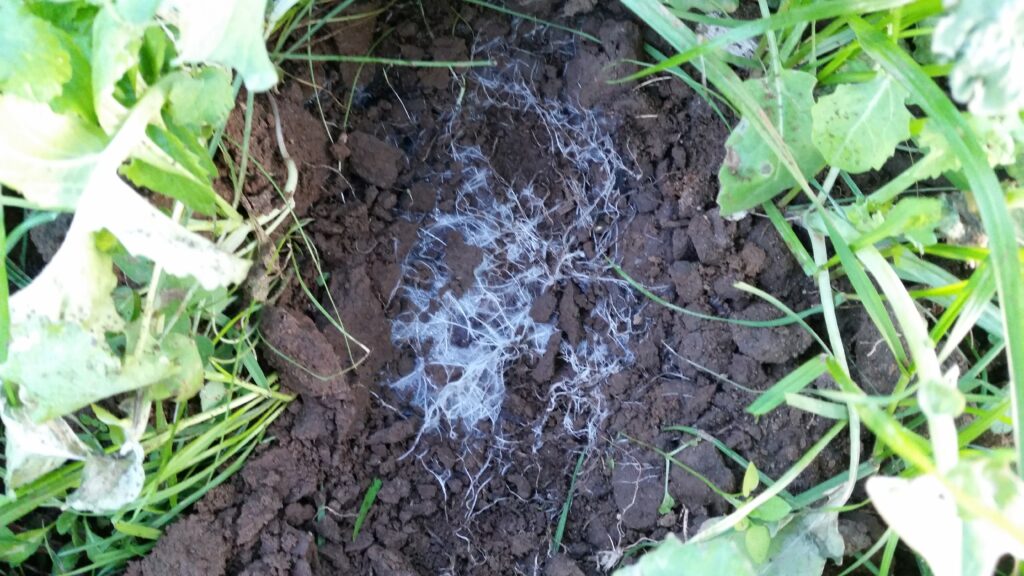
Fine roots shown growing where a small rock was removed.
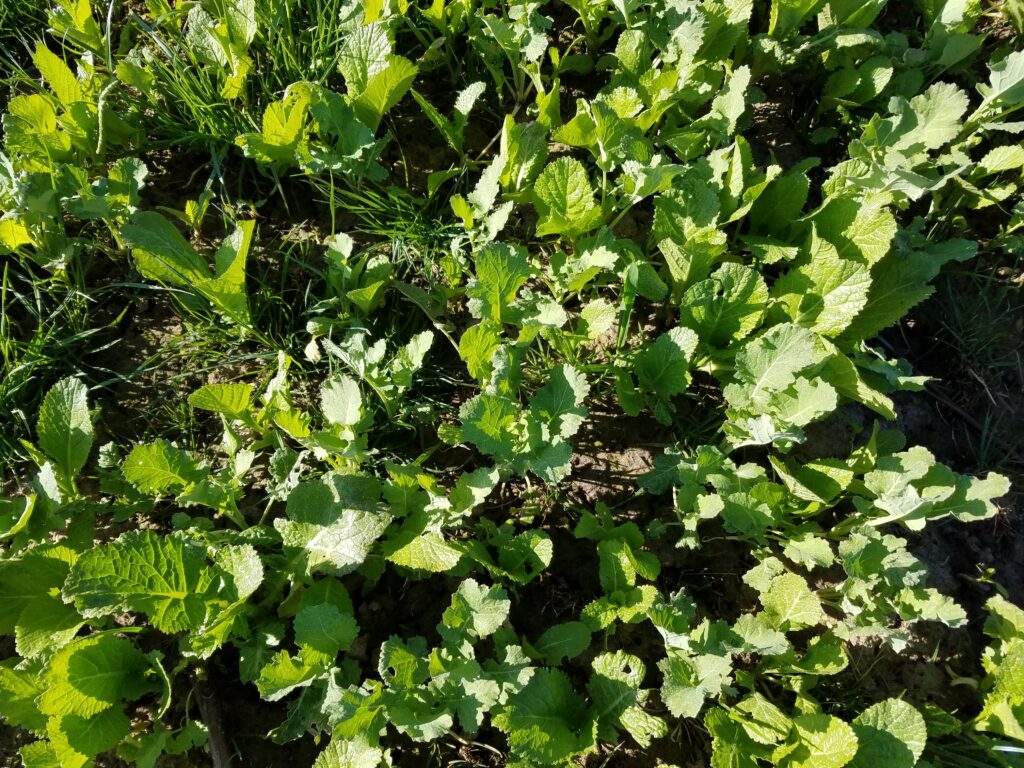
A young stand of radish. The radish proved cheap, reliable and effective when planted as a single species or a mix.

Mature tillage radish: This fall planted radish shown 60 days later. The growth of the radish was remarkable.
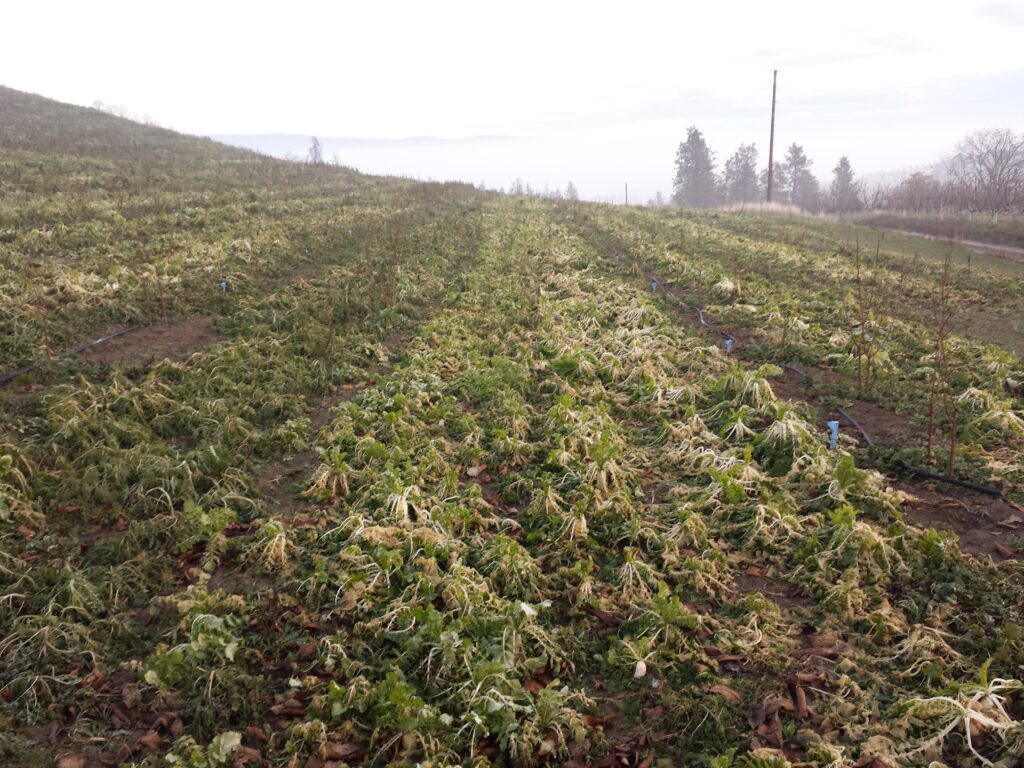
Freshly winter-killed radish: Radish generally grew into January when the temperatures dropped enough for them to winterkill. An occasional radish would survive all winter.
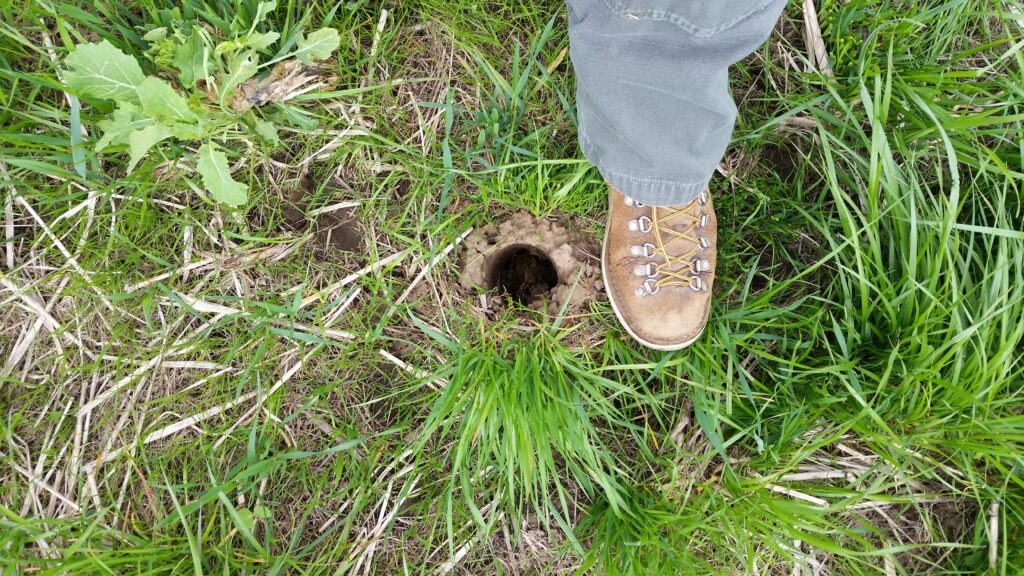
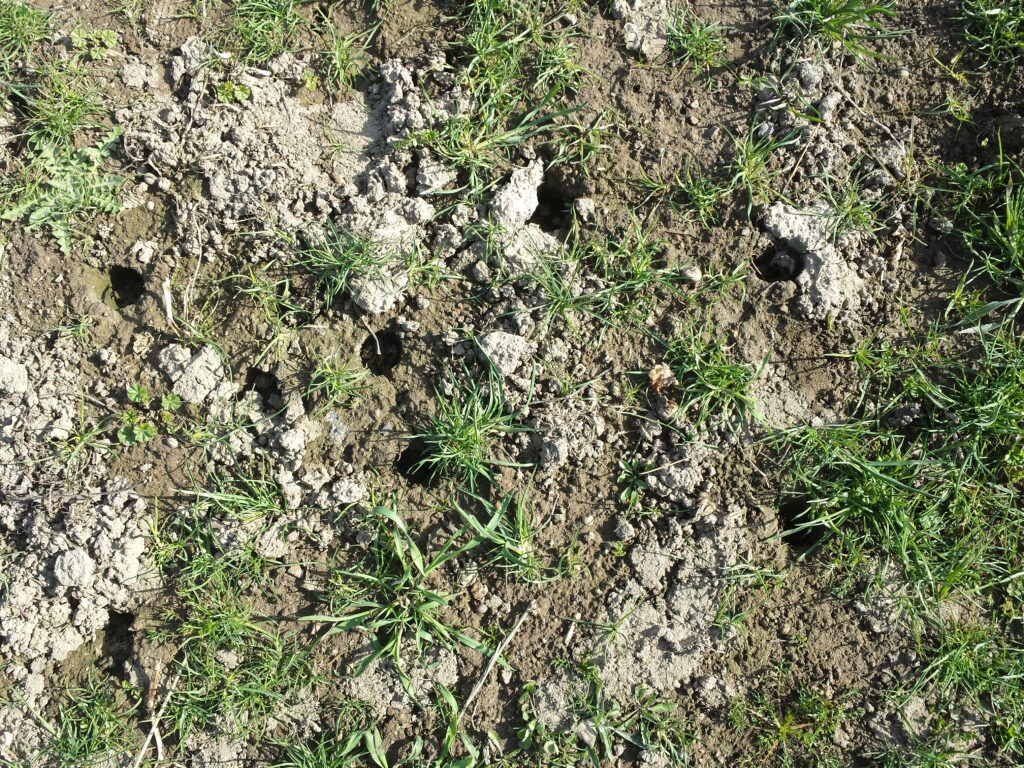
Radish root holes: The holes that winter-killed radish left behind were numerous. Some like the top photo were huge.
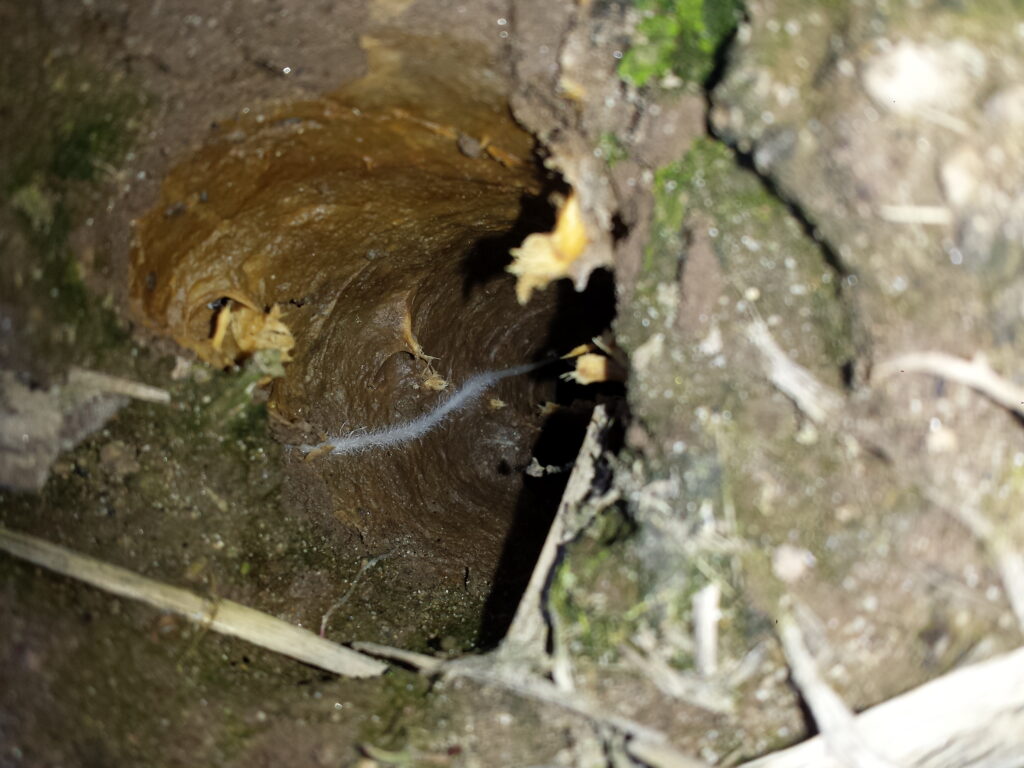
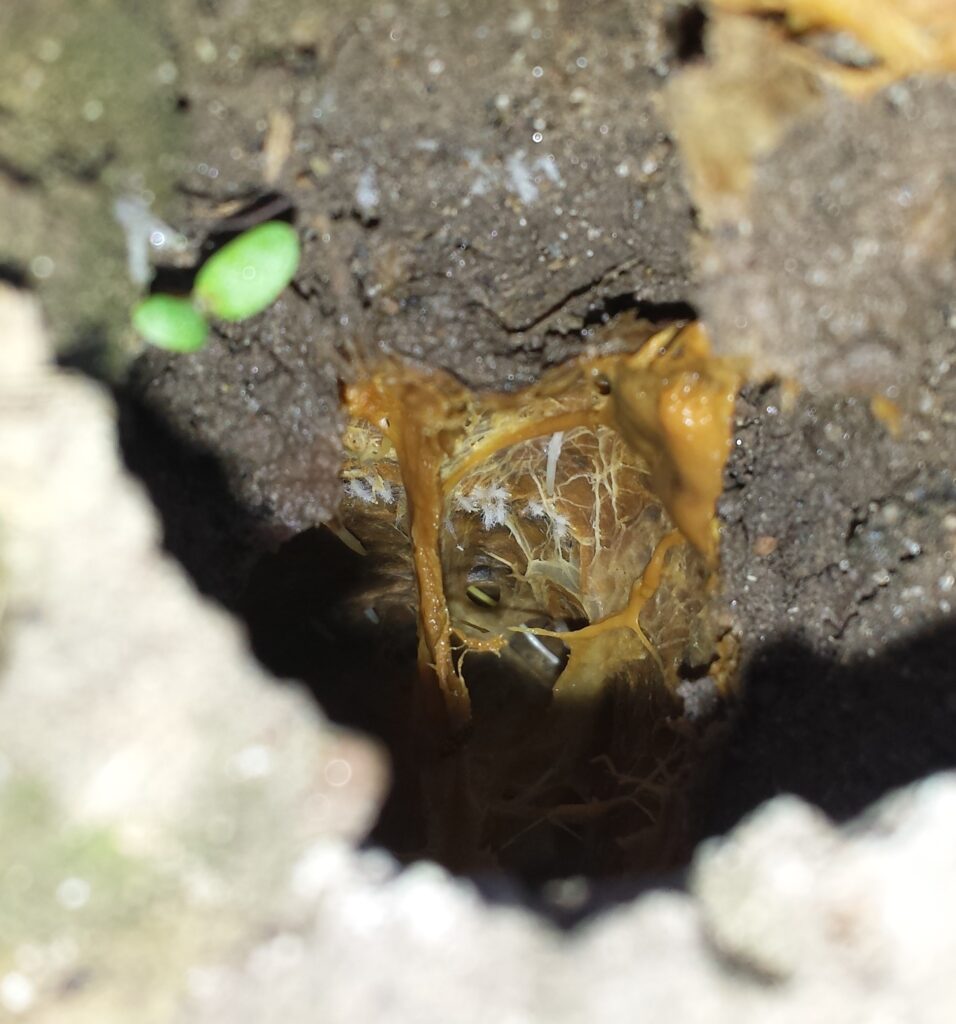
A small roots from close-by plants that survived the winter were commonly seen growing down the holes left behind by the radish.
Leaf, Shoot and Fruit Sampling
Leaf Samples: We did not detect any differences between leaf samples in the trees over several years of data collection.
Shoot Extension: No differences in shoot extension or caliper were observed in the trial between treatments.
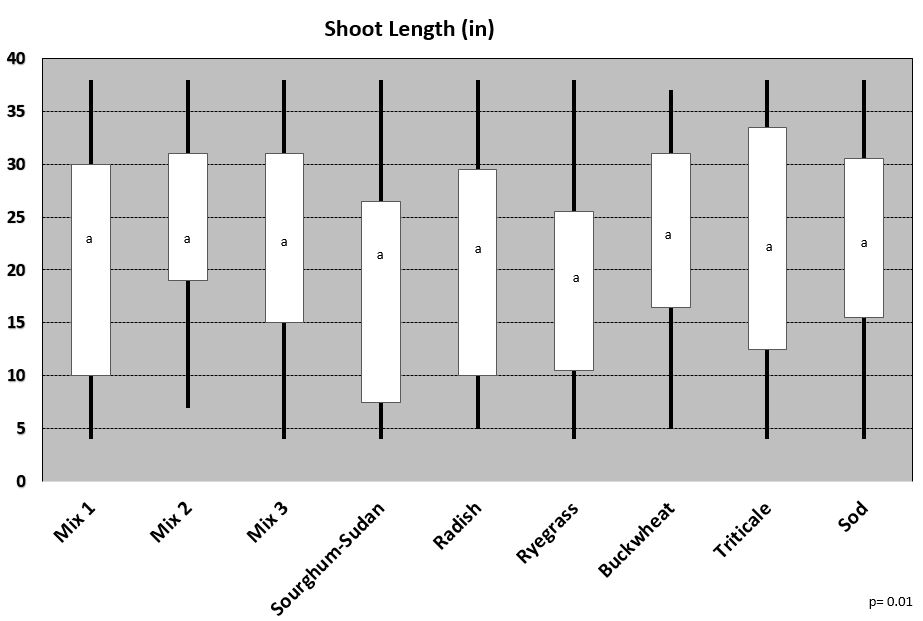
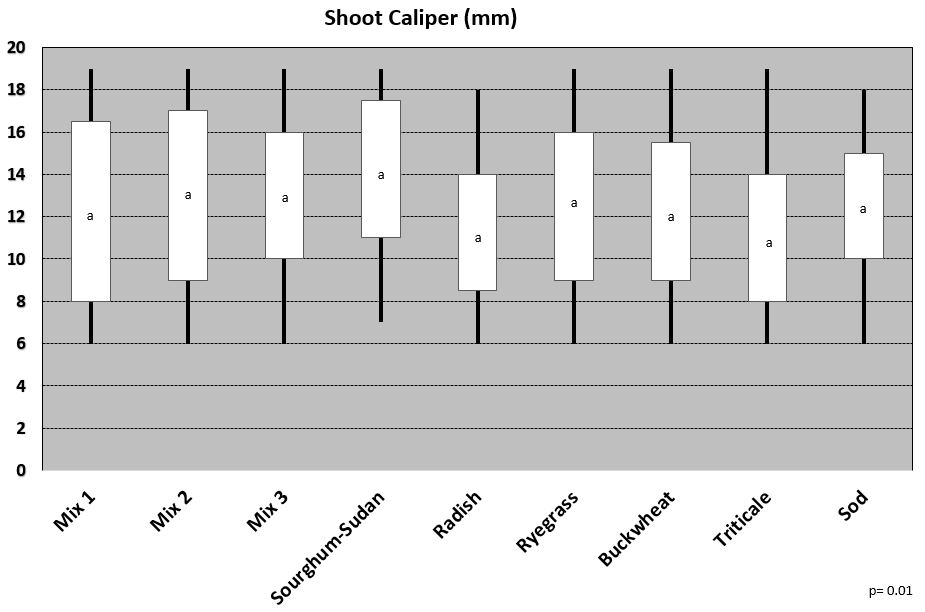
Fruit Sampling: No differences in fruit size or firmness was detected between treatments. Yields were visually estimated to be the same.
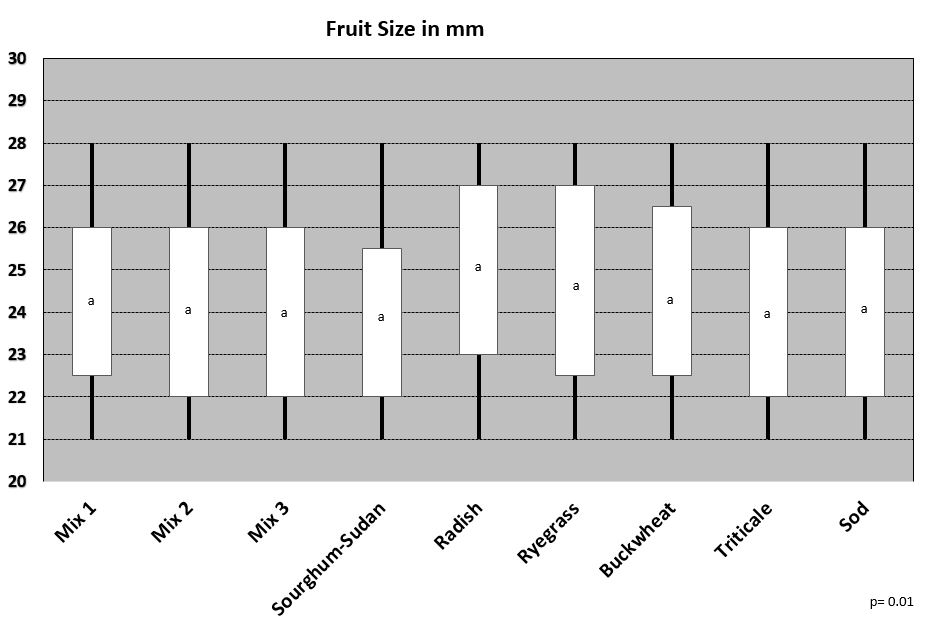
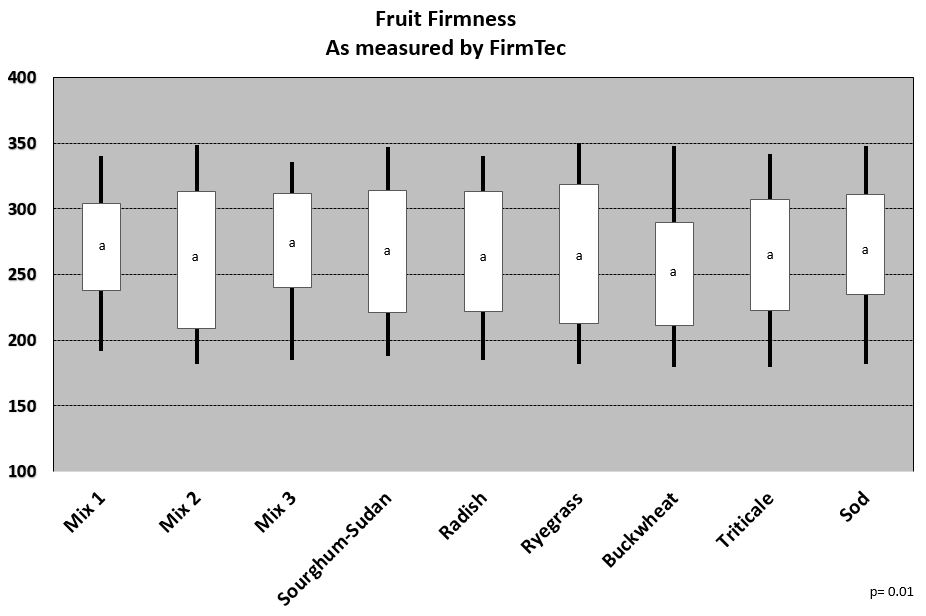
Soil Sampling
- Soil Samples
Below are the average nutrient levels from soil samples taken in the alleyway. We present N forms, P, K, Ca, Mg and S as those are generally considered the most important nutrients by local orchardists. We do not believe these differences to be significant. We did not see difference in nutrients between plating equipment used.
|
Treatment |
NH3-N ppm |
NO3-N ppm |
P ppm |
K ppm |
Ca ppm |
Mg ppm |
S ppm |
|
Mix 1 |
0.2 |
23.5 |
48 |
514 |
1519 |
190 |
13 |
|
Mix 2 |
0.6 |
52.8 |
46 |
467 |
1694 |
183 |
12 |
|
Mix 3 |
0.2 |
28.8 |
51 |
359 |
1604 |
171 |
13 |
|
Sorghum-sudan |
0.2 |
24.5 |
46 |
438 |
1552 |
167 |
13 |
|
‘Enricher’ Radish |
0.2 |
25.6 |
50 |
564 |
1644 |
243 |
12 |
|
‘Bounty’ Ryegrass |
0.2 |
27.8 |
49 |
487 |
1554 |
238 |
10 |
|
Buckwheat |
0.2 |
31.0 |
51 |
565 |
1660 |
169 |
12 |
|
Triticale |
0.2 |
24.9 |
47 |
352 |
1746 |
214 |
14 |
|
Sod control |
0.1 |
32.1 |
48 |
460 |
1748 |
194 |
10 |
- Penetrometer
The cover crops had a positive influence in soil compaction based on the penetrometer readings. All of the cover crops reduced compaction vs the sod cover crop. The radish single species lead to a significant reduction in penetrometer readings. In the table below are the pressure at 6 inches depth. We felt this would limit the influence of light tillage on the readings.
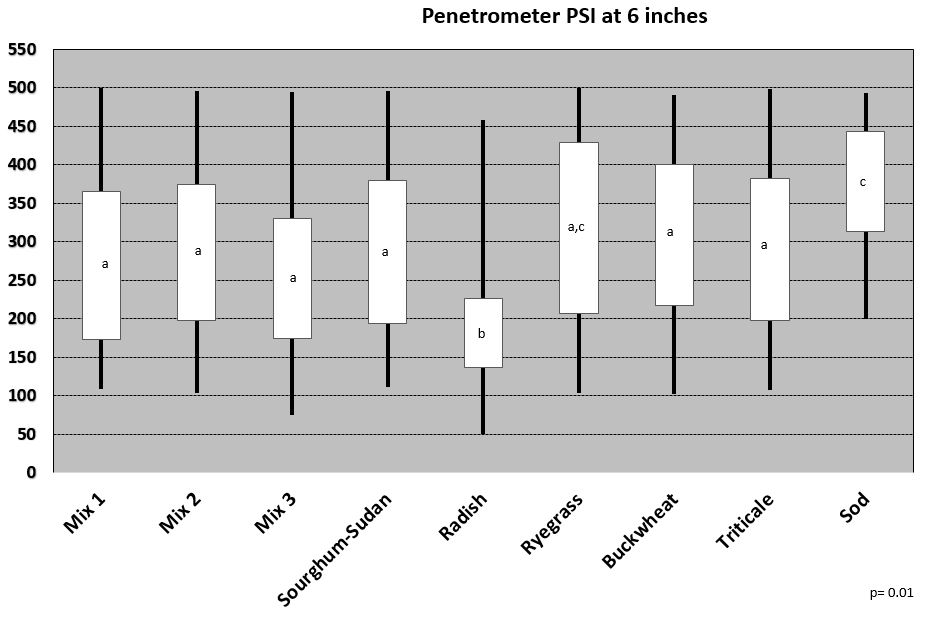
- Soil infiltration
The cover crops increased infiltration rate in the alleyway soil. The single species radish had a particularly dramatic increase in infiltration rate. This is understandable as it was sometimes hard to find an area to test that did not have a radish root hole in the soil.
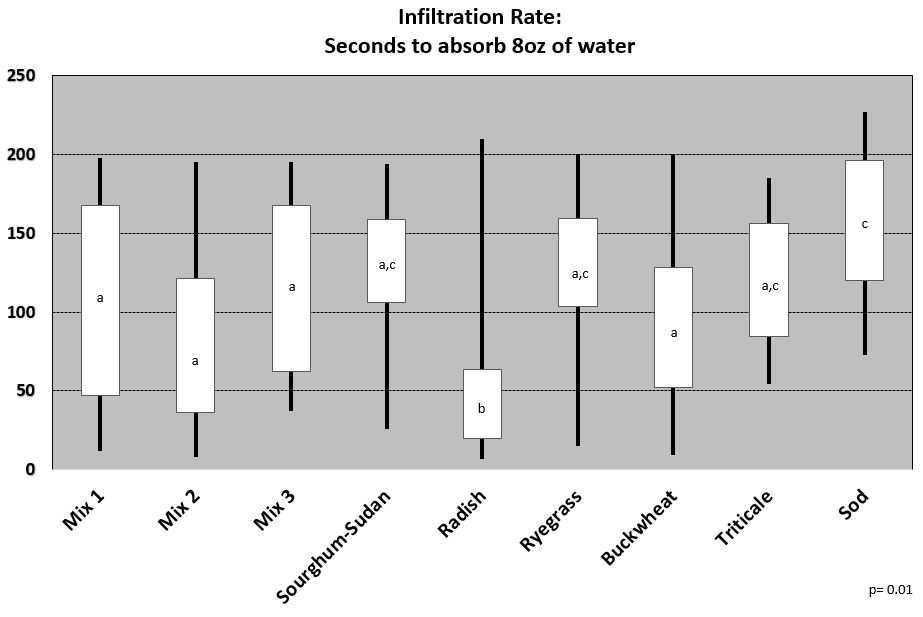
Expenses
Seed costs. The rate and cost per acre of each cover crop treatment is outlined below. Note that these costs are for each planted acre of cover crop. To calculate cost per acre of orchard the grower would need to calculate the % of their orchard acre that is alleyway and multiply that into the cost. For example: If your alleyway is 10 ft wide and your tree rows are 16ft apart then the % alley = 0.625 or 62.5%. Therefore for mix 3, which is $42/cover crop acre would cost the grower $42 x 0.625 = $26.25 per orchard acre.
|
Treatment |
Planting Rate (lb/ac) Using harrow |
Seed cost/cover crop acre |
|
Mix 1 |
25 |
$48.30 |
|
Mix 2 |
50 |
$50.37 |
|
Mix 3 |
25 |
$42.00 |
|
Sorghum-sudan |
35 |
$17.50 |
|
‘Enricher’ Radish |
6 |
$15.00 |
|
‘Bounty’ Ryegrass |
15 |
$21.60 |
|
Buckwheat |
50 |
$40.00 |
|
Triticale |
75 |
$60.00 |
|
Sod control |
--- |
--- |
Planting costs:
Planting costs varied considerably depending upon the machinery used. Our costs calculations for each of the machinery are noted below.
|
Item |
ATV |
No-Till Drill |
Power Harrow |
|
Equipment |
Pass 1: cultivate alleyway with Tractor & Tiller - $12.58 Pass 2: Apply seed with ATV- $3.48 Pass 3: Rake over seed with ATV pulling drag - $3.48 Total: $19.54 |
Pass 1: Spray alleyway with tractor & boom - $13.52 Pass 2: Drill in seed with tractor and drill - $12.58 Sub-total: $26.10 |
Pass 1: Tractor & harrow - $18.26
|
|
Labor |
Pass 1- $5.26 Pass 2- $3.48 Pass 3- $3.48 Total: $12.22 |
Pass 1- $7.15 Pass 2- $5.26 Sub-total: $12.41 |
Pass 1: $6.50 |
|
Total |
$31.76 |
$38.51 |
$24.76 |
We did not figure the cost of purchasing or renting the equipment into our study as the per acre costs would depend upon the number of acres treated. However, the equipment costs are listed below for reference:
- ATV seeder - $250
- No-Till Drill - $15,000
- Power Harrow and Seeder - $11,000
Additional Labor/Management:
There was no additional labor or management for the cover crops vs sod. Weed control was never an issue in any treatment.
Income:
As there was no difference in fruit/size or quality there was no increase in income using cover crops.
Mow and Blow
By the third year of the project the lack of response in shoot growth and fruit size/quality from the cover crops was perplexing as there were measurable improvements in the alleyway soil from the cover crops. The data collected from the penetrometer pressures and soil absorption rates clearly showed the soil in the orchard was improving. Yet the trees did not seem to be benefiting from these improvements in soil quality. Upon evaluating the soil in the tree rows themselves we soon realized that the tree row soil was not improving, only the alleyway soil. This result is not surprising as the tree rows had no cover crops planted into them and were being maintained bare ground “strips” through herbicides, as is industry standard practice. When we dug in the alleyway soil we found very few if any tree roots growing into the alleyway. Since the tree roots were not growing into the alleyway the improvements to the soil there from the cover crops were not contributing to the trees and their crop. Research led us to Michael Phillips book, The Holistic Orchard, where he described the behavior of tree roots and their interaction with grasses and broadleafs growing near trees. His conclusion was that the tree roots cannot compete well with the plants growing in the alleyways because the tree is adapted to growing in forest ecosystems, not prairies. He further describes that the optimal environment for tree roots to grow in is a forest duff. Phillips uses mulches to create a forest-like duff around his fruit trees. Upon reading his work we realized that we needed to mulch the cover crops into the tree rows so the trees could realize the benefits of cover cropping. However he was only doing this work on a small scale using methods not suited for large-scale commercial farming.
Through further research we discovered that “mow and blow” was a technique that some vineyard growers were using to mulch their vineyards. Mow and blow is pretty simple: a mower cuts the plants in the alleyway and deposits the mulch into the tree row. We searched for a mower that would allow us to do mow and blow. Eventually we found the Nobili SDS 210 flail mower with an independent hydraulic system drive and a single-side auger discharge to mow and blow our cover crops. This unit was affordable and did an excellent job for us. We purchased a second machine of the same model to allow us to mow and blow all of our orchard acres with these mowers. To date six area orchardists have purchased the same mower from the local equipment dealer as a result of us demonstrating the mower at field days held as part of this project. These mowers are durable and parts are readily available for when we have a rare breakdown.
Mow and blow is working very well for us. Large amounts of mulch can be grown in the alleyway and deposited easily into the tree row. There is not additional operational cost as mowing is already done as a standard orchard practice. But instead of leaving the mulch in the alleyway, where the project demonstrates that mulch has little to no benefit to the trees, the mulch is deposited in the tree row where it can go to work for the grower.
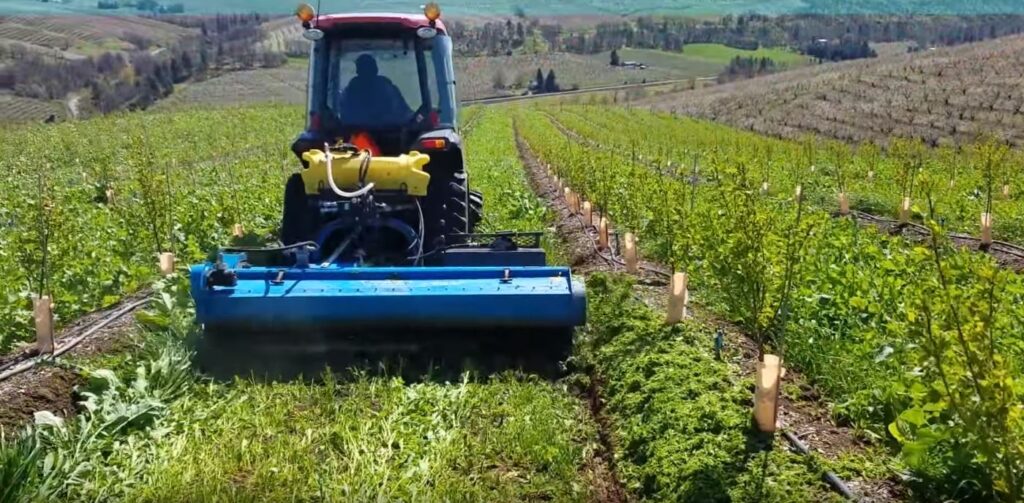
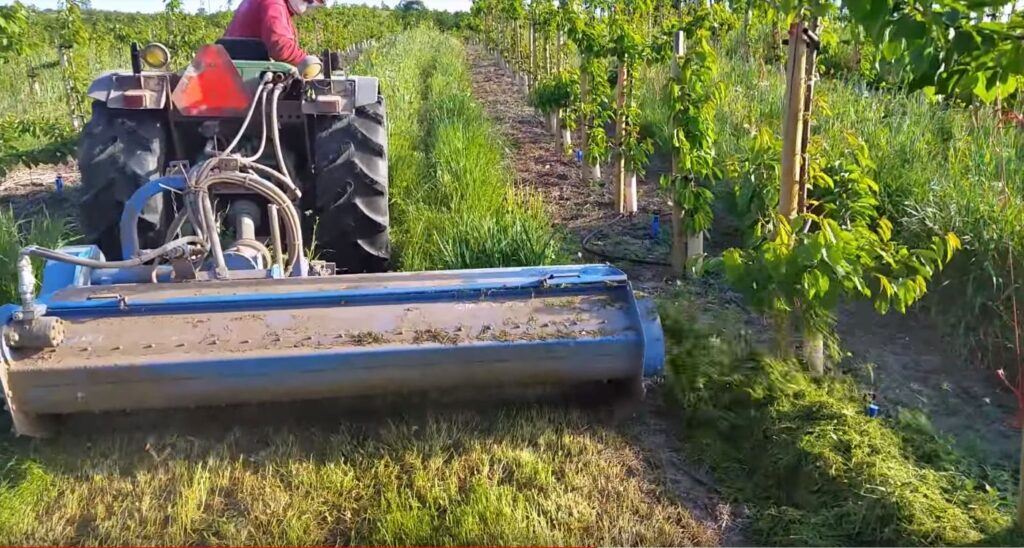
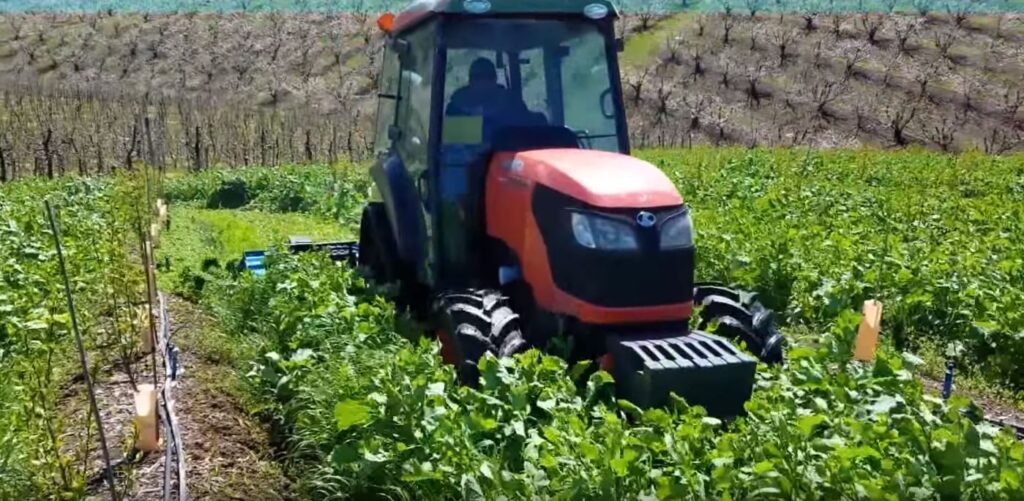
"Mow and Blow": The Nobili SDS 210 flail mower did an amazing job of mowing down cover crops and depositing valuable mulch into the tree row.
Research Outcomes
Education and Outreach
Participation Summary:
Workshops
Three workshops featuring cover crops and information generated by this workshop were held:
- A soil health workshop, sponsored by OSU Wasco County Extension and Omeg Orchard (via this project) was held on March 16, 2017. The first half of the day features lectures from several speakers who presented about various health subjects. The second half of the day was spent in the field at Omeg Orchards talking about cover crops and mulching. Further information, including some of the presentations can be seen on the Wasco County Extension Soil Health webpage. About 100 growers from Oregon and Washington were in attendance.
- The OSU Wasco County Extension office held its annual Pre-harvest tour on June 1, 2017. One of the stops was at Omeg Orchards where Mike Omeg presented on how to establish and the economics of cover crops and green manures. There were about 200 growers in attendance.
- On June 5, 2018 Mike Omeg and Garett Duyck of the USDA NRCS presented the results of the cover crop trial at OSU Wasco County Extension's annual preharvest tour. Ashley Thompson, OSU Wasco County Extension Agent counted 208 people in attendance.
Print Media
The Good Fruit Grower, the leading trade journal of temperate fruits, did two articles relating to the project:
- Article 1: What lies beneath: A researcher seeks to determine which indicators are most important in soil
- Article 2: Make the most of your mulch: Pruning wood and mowing weeds can provide extra food for soil organisms that help keep trees healthy
Growing Produce wrote an article Maximize Produce Profits By Focusing On Soil Health featuring the cover crop work of Mike Omeg.
The USDA Natural Resources Conservation Service wrote a feature article for the Profiles in Soil Health series featuring Mike Omeg and his work with cover crops in orchards. The print article can be downloaded as a PDF as well.
Video Media
The Good Fruit Grower produced a YouTube video Make the most of your mulch with Mike Omeg on mulching and cover cropping featuring Mike Omeg.
Mike Omeg has an active YouTube channel where he talks about biologically-centered farming including cover cropping. There are many videos on his channel. A few selected videos generated by the work from this project include:
- Mulching cover crop with side discharge Nobili SDS flail - 4,551 views
- Mow and blow cover crop using Nobili SDS flail - 5,268 views
- Tillage Radish in Orchards - 1,740 views
- Orchard cover cropping in existing sod using Moreni power harrow - 1,798 views
- Seeding orchard cover crop using Moreni power harrow - 3,096 views
Education and Outreach Outcomes
Mow and blow of cover crops.